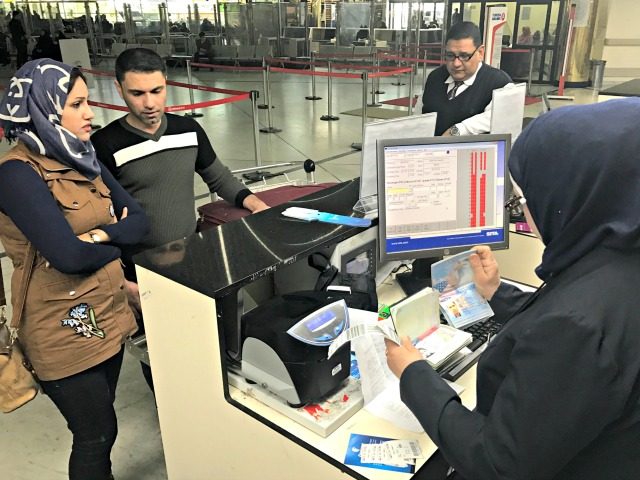President Donald Trump and his top aides are expected to debate next week how many refugees to invite into the United States in 2020 — and progressives fear the refugee number may be zero.
“In meetings over the past several weeks, one top administration official has proposed zeroing out the [refugee] program altogether, while leaving the president with the ability to admit refugees in an emergency,” according to a report in the New York Times, which continued:
Another option that top officials are weighing would cut refugee admissions by half or more, to 10,000 to 15,000 people, but reserve most of those spots for refugees from a few handpicked countries or groups with special status, such as Iraqis and Afghans who work alongside American troops, diplomats and intelligence operatives abroad.
Pro-migration groups demand higher inflows, partly because they are paid for every refugee they bring into the United States.
Business groups want refugees to fill a variety of tough, low-wage jobs, such as milking cows and slaughtering animals.
Local governments often seek more migrant workers, but community groups typically oppose the sudden rush of foreign migrants who change neighborhoods, preserve low-quality industries, lower wages, shrink classroom help for local kids, and add diverse civic practices to their local politics.
In 2016, President Barack Obama pushed to expand refugee inflows to about 100,000 per year amid cheers for pro-migration and business groups.
But President Donald Trump forced the 2019 inflow down to a target of 30,000 refugees. The reform earned applause from groups that favor stable communities and higher-wage jobs for Americans.
The New York Times reported:
The issue is expected to come to a head on Tuesday, when the White House plans to convene a high-level meeting in the Situation Room to discuss at what number Mr. Trump should set the annual, presidentially determined ceiling on refugee admissions for the coming year.
…
For two years, Stephen Miller, Mr. Trump’s top immigration adviser, has used his considerable influence in the West Wing to reduce the refugee ceiling to its lowest levels in history, capping the program at 30,000 this year. That is a more than 70 percent cut from its level when President Barack Obama left office.
In mid-July, Politico reported:
During a key meeting of security officials on refugee admissions last week, a U.S. Citizenship and Immigration Services representative who is closely aligned with White House immigration adviser Stephen Miller suggested setting a cap at zero, the people said. Homeland Security Department officials at the meeting later floated making the level anywhere from 3,000 to 10,000, according to one of the people.
…
USCIS official John Zadrozny and the State Department’s Andrew Veprek — both known as Miller allies — argued in the meeting that the refugee cap should be low because of ongoing security concerns and the ability of the U.S. to offer humanitarian protections through the asylum process, according to an attendee.
Pentagon officials have lobbied for higher inflows, mostly to reward cooperation from local populations in Iraq, Afghanistan, and other countries. Politico reported that “only 140 [Iraqis] have entered so far this year [ans] more than 100,000 remain in the queue, according to an analysis provide by refugee groups.”
Immigration has frozen middle-class wages in California for 40 years. That's part of why any debate over immigration economics is taboo among journalists in the establishment media. https://t.co/LJ7xMtV9Pb
— Neil Munro (@NeilMunroDC) September 3, 2019
Immigration Numbers:
Each year, roughly four million young Americans join the workforce after graduating from high school or university. This total includes about 800,000 Americans who graduate with skilled degrees in business or health care, engineering or science, software, or statistics.
But the federal government then imports about 1.1 million legal immigrants and refreshes a resident population of about 1.5 million white-collar visa workers — including approximately 1 million H-1B workers and spouses — and about 500,000 blue-collar visa workers.
The government also prints out more than 1 million work permits for foreigners, it tolerates about 8 million illegal workers, and it does not punish companies for employing the hundreds of thousands of illegal migrants who sneak across the border or overstay their legal visas each year.
This policy of inflating the labor supply boosts economic growth for investors because it transfers wages to investors and ensures that employers do not have to compete for American workers by offering higher wages and better working conditions.
This policy of flooding the market with cheap, foreign, white-collar graduates and blue-collar labor also shifts enormous wealth from young employees towards older investors, even as it also widens wealth gaps, reduces high-tech investment, increases state and local tax burdens, and hurts children’s schools and college educations.
The cheap-labor economic strategy also pushes Americans away from high-tech careers and sidelines millions of marginalized Americans, including many who are now struggling with fentanyl addictions.
The labor policy also moves business investment and wealth from the Heartland to the coastal cities, explodes rents and housing costs, undermines suburbia, shrivels real estate values in the Midwest, and rewards investors for creating low-tech, labor-intensive workplaces.
Cornell study shows that bad economic policy hurts women's (rational) hopes of marrying higher-income men. So we should see feminists celebrating wage raises in Trump's economy, right? https://t.co/lfYW9ycxDM
— Neil Munro (@NeilMunroDC) September 6, 2019

COMMENTS
Please let us know if you're having issues with commenting.